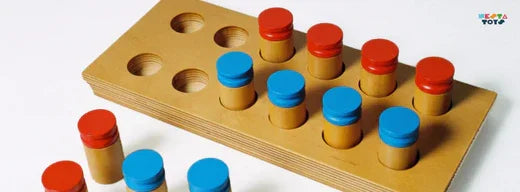Aims:
- To enhance the child's sense of smell by introducing them to various scents, fostering olfactory awareness and sensory development.
- To develop the child's ability to recognize and differentiate between a variety of scents through hands-on exploration.
- To cultivate curiosity and an appreciation for the wide range of smells in the environment.
- To promote concentration and attention to detail.
- To inspire the child to explore and appreciate a wide range of scents in their environment.
- To spark interest in discovering the unique qualities of different scents.
- To refine the child’s olfactory discrimination skills.
- To nurture the child's sensory perception by actively engaging their sense of smell.
Material Description:
The Montessori Smelling Bottles set consists of eight bottles with perforated lids, each containing a distinct scent. The set features four pairs of bottles, with each pair designed to be matched based on similar aromas.
- Set 1: Floral Scents (e.g., Lavender, Rose)
- Set 2: Herb Scents (e.g., Basil, Mint)
- Set 3: Kitchen Scents (e.g., Coffee, Cinnamon)
- Set 4: Incense Scents (e.g., Sandalwood, Jasmine)
- Set 5: Cosmetic Scents (e.g., Lavender, Vanilla)
- Set 6: Cooking Oils (e.g., Olive oil, Coconut oil)
- Set 7: Fruit Scents (e.g., Lemon, Orange)
- Set 8: Earthy Scents (e.g., Fresh Grass, Wood)
Each pair of bottles within a set has a color dot at the base for easy pairing, allowing children to match the bottles based on scent.
Activity Description:
- Introduce the Material: Start by introducing the bottles to your child and have them carry the material to the work mat. Begin by showing one bottle and explaining the process of smelling it.
- Smelling and Pairing: Open the bottle and smell its contents. Guide the child to do the same, ensuring that they close the bottle after each smell. Encourage them to keep the bottle a little below chin level to avoid overwhelming their senses. After a brief pause, the child can smell the bottle again. The goal is to experience the scent at a minimal intensity to refine the olfactory sense.
- Matching Process: Separate the bottles into two sets. Select one bottle, smell it, and try to find its match in the second set. Any mismatched bottles are set aside. Once a pair is matched, place them side by side.
- Control of Error: After pairing the bottles, guide the child to check for correctness by cross-referencing the color dots at the base of the bottles.
- Child's Turn: Allow the child to repeat the matching process independently. Offer assistance as needed while ensuring the child can manage the task on their own.
- Reorganization for Another Round: Once all the bottles are matched, help the child mix up the sets for another round of activity. This reinforces the learning process and provides further practice in olfactory discrimination.
Through this activity, your child not only enhances their sense of smell but also learns to focus, concentrate, and develop memory recall.









